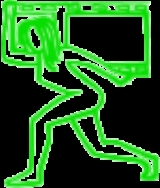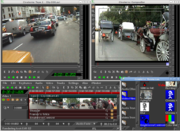
video editing software
. It is designed for the GNU/Linux
operating system
. It is produced by Heroine Virtual
, and is free software
distributed under the GNU General Public License
. Cinelerra also includes a video compositing
engine, allowing the user to perform common compositing operations such as keying and mattes
.
Cinelerra was first released August 1, 2002, and was based in part on an earlier product known as Broadcast 2000. Broadcast 2000 was withdrawn by Heroine Virtual in September 2001.
Notable features
Cinelerra includes support for very high-fidelity audio and video: it processes audio using 64 bits of precision, and can work in both RGBAand YUVA
color space
s, using floating-point and 16-bit integer representations, respectively. It is resolution
and frame rate
-independent, meaning that it can support video of any speed and size. The application has a wide range of features.
Cinelerra interface

video-editing systems, such as Adobe Premiere Pro
. However, because it includes a compositing engine, it may also be likened to compositing software such as Adobe After Effects
or Shake
. The user is presented with four screens:
- The timeline, which gives the user a time-based view of all video and audio tracks in the project, as well as keyframe data for e.g. camera movement, effects, or opacity;
- the viewer, which gives the user a method of "scrubbing" through footage;
- the resource window, which presents the user with a view of all audio and video resources in the project, as well as available audio and video effects and transitions; and
- the compositor, which presents the user with a view of the final project as it would look when rendered. The compositor is interactive in that it allows the user to adjust the positions of video objects; it also updates in response to user input.
Cinelerra's interface is frequently criticized because it does not conform to either GNOME
or KDE
Human interface guidelines
.
Cinelerra usage and awards
Cinelerra has gained ground among some Linux enthusiasts looking for a native video editing system. Professional use is mostly promoted by Linux Media Arts, which sells an integrated hardware and software package for video production that includes Cinelerra.At the National Association of Broadcasters
' 2004 Electronic Media Show, Cinelerra was awarded Bob Turner's "Making the Cut" award. The award is given to "the best and most exciting postproduction products seen at the convention".
The Community Version
Heroine Virtual generates a new release of Cinelerra semi-annually, available as source code only. Any bugs and usability issues found and resolved by the community that are submitted to Heroine Virtual often result in no immediate response, and it is not until a new release that there is any indication that Heroine Virtual has incorporated these changes. Because of both the latency in development and the distribution-specific nature of the release, a group of free and open-source software developers created their own version of Cinelerra referred to as Cinelerra-CV (where CV stands for Community Version).Cinelerra-CV allows the community to contribute to an open repository where changes to the code are accessible to everyone. Mailing lists and an IRC channel exist where more experienced users and developers can provide support to less experienced users, and developers can hold technical discussions. Cinelerra-CV is also packaged for a wider range of distributions. It also has a different compilation
system: system libraries are used extensively, and the autoconf
/automake
tools are used to configure the compilation system.
Although Cinelerra-CV may technically be called a fork, the relationship between Heroine Virtual and Cinelerra-CV is rather friendly. Heroine Virtual at times contributes to discussions on the mailing lists, and incorporates many of the changes made in the repository. Heroine Virtual posted the following message on their website describing the relationship:
The versioning of Cinelerra-CV follows that of Heroine Virtual. After Heroine Virtual produces a release, Cinelerra-CV examines the changes introduced by the new version and merges them into their version. CV is appended to the end of the version number to indicate the community version. (For example, after the 2.1 merger the CV version is labeled 2.1CV.)
Lumiera rewrite
In the beginning of April 2008, the Cinelerra community announced a complete rewrite of the current community version, named as Lumiera. It was born as a rewrite of the Cinelerra codebase called Cinelerra3 but soon was separated into an independent project with its own name. Lumiera is still in an early stage of development, but has been making continuous progress (as of 5/2011) and now has a binary Debian build of the development preview available.History
| Date | Releases |
|---|---|
| August 6, 2011 | Cinelerra 4.3 released. |
| October 15, 2010 | Mainly a bugfix & personal need release.
|
| September 24, 2009 | Cinelerra 4.1 released. Main feature is nested sequences. |
| August 8, 2008 | Cinelerra 4.0 released |
| September 7, 2006 | Cinelerra 2.1 merged into a community SVN version. (The first use of git Git (software) Git is a distributed revision control system with an emphasis on speed. Git was initially designed and developed by Linus Torvalds for Linux kernel development. Every Git working directory is a full-fledged repository with complete history and full revision tracking capabilities, not dependent on... and a multi-person merge) |
| July 2, 2006 | Cinelerra 2.1 released |
| September 29, 2005 | Cinelerra 2.0 merged into a community SVN version. |
| September 12, 2005 | Cinelerra 2.0 released H.264 encoding and MPEG-4 audio encoding. Import MPEG video directly. |
| January 18, 2005 | Cinelerra 1.2.2 merged into a community CVS version. |
| January 10, 2005 | Cinelerra 1.2.2 released |
| August 16, 2004 | Cinelerra 1.2.1 merged into a community CVS version. |
| August 8, 2004 | Cinelerra 1.2.1 released
|
| May 11, 2004 | Cinelerra 1.2.0 released
|
| February 17, 2004 | Cinelerra 1.1.9 merged into a community CVS version. |
| February 11, 2004 | Cinelerra 1.1.9 released
|
| October 5, 2003 | Cinelerra 1.1.7 merged into a community CVS version. |
| August 11, 2003 | Cinelerra 1.1.7 released |
| May 12, 2003 | Cinelerra 1.1.6 released |
| April 29, 2003 | Cinelerra 1.1.5 code "forked" into a community CVS version. |
| August 1, 2002 | Cinelerra 1.0.0 released |
See also
- Comparison of video editing softwareComparison of video editing softwareThis is a comparison of non-linear video editing software applications. See also a more complete list of video editing software.-General information:This table gives basic general information about the different editors:- System requirements :...
- KdenliveKdenliveKdenlive is an open source video editing software package based on the MLT Framework that focuses on flexibility and ease of use...
- PiTiViPiTiViPiTiVi is a open source non-linear video editor developed by Collabora and contributors from the worldwide community. It is licensed under the terms of the GNU Lesser General Public License. PiTiVi is designed to be intuitive video editing software that integrates well in the GNOME desktop...

